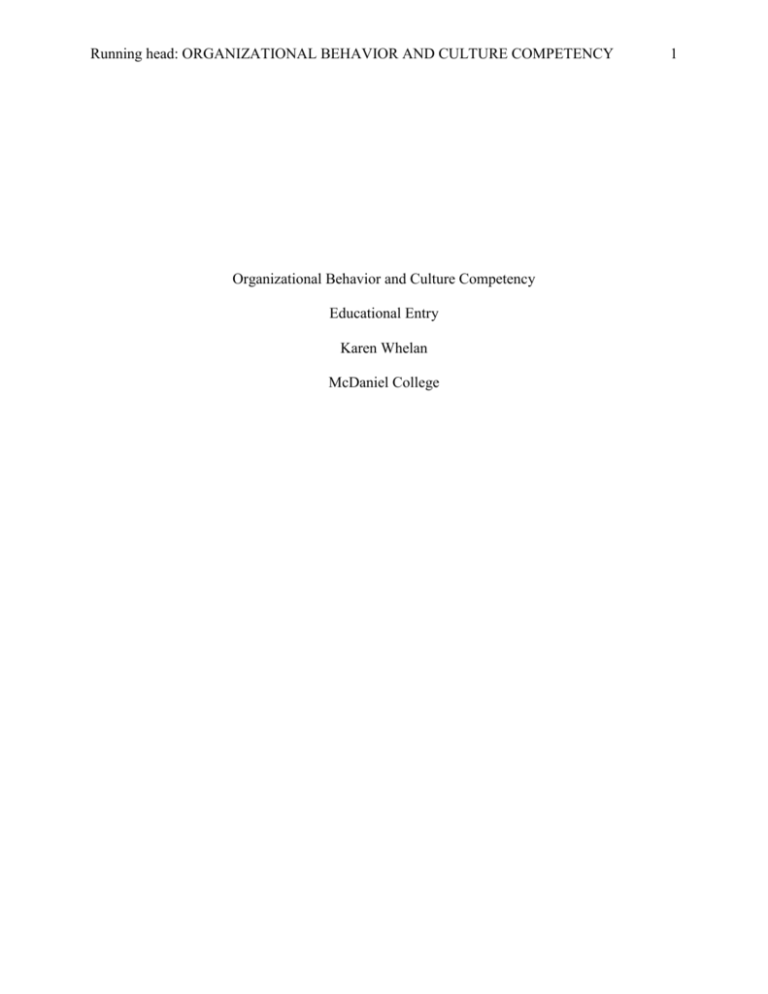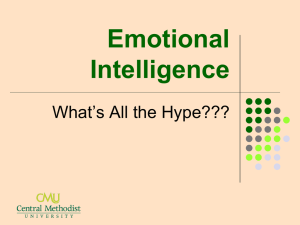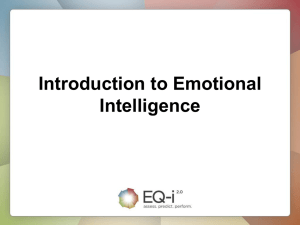Organizational Behavior and Culture Competency
advertisement

Running head: ORGANIZATIONAL BEHAVIOR AND CULTURE COMPETENCY Organizational Behavior and Culture Competency Educational Entry Karen Whelan McDaniel College 1 ORGANIZATIONAL BEHAVIOR AND CULTURE COMPETENCY 2 The Master’s of Science in Human Resources Development program requires students to take an Organization Theory and Behavior course. Within the course, students learn fundamental concepts pertaining to organizational theory, which includes motivation, communication and teamwork, leadership, organizational change, and conflict and conflict resolution. One of the assignments for this class was to reflect on classic readings written by organizational theorists. In one of my papers, I chose to reflect on Daniel Goleman’s 1998 publication, “What Makes a Leader,” which discusses emotional intelligence. Goleman identifies five components of emotional intelligence; self-awareness, self-regulation, motivation, empathy, and social skills. I learned that emotional intelligence is critical to executing organizational intervention strategies in light of organizational behavior and culture. For this reason, this paper fits objective number four as an educational entry. The first component of emotional intelligence that Goleman identifies is self-awareness. I learned that self-awareness is when one understands their strengths, weaknesses, values, goals, emotions, and drives in the workplace. Characteristics include speaking articulately, owning up to failure, openness with emotions, having a sense of humor, knowing limitations, and being energized by the work itself. The second component of emotional intelligence that Goleman identifies is selfregulation. I learned that self-regulation refers to one’s ability to keep their feelings under control. Characteristics include comfort with uncertainty and change and integrity. Leaders who demonstrate self-regulation create an environment of trust and fairness, have a high retention rate, and competitive edge. The third component of emotional intelligence that Goleman identifies is motivation. Goldman defines motivation as one’s desire to achieve for the “sake of achievement” (Goleman, ORGANIZATIONAL BEHAVIOR AND CULTURE COMPETENCY 3 1998). In other words, I learned that leaders should not be motivated by external factors, such as money. Characteristics include optimism, an energetic nature, looking for new ways to do their work, pride, and commitment. The fourth component of emotional intelligence that Goleman identifies is empathy. I learned that empathy is one’s knack to understand the emotions of others and behave towards them appropriately. Characteristics include being able to retain talent and provide superior service to others. The final component of emotional intelligence that Goleman identifies is social skills. I learned that social skills are necessary to build relationships and move people in a desired direction. Characteristics include a talent for building relationships with others and being persuasive. Emotional intelligence is linked to organizational behavior and culture in that organizations are created by people, who are not emotion-free. In other words, “organizational behavior [is] intrinsically linked to human emotions” (Stadler, 2007, p. 2) and, thus, emotions should be used to shape organizational behavior. Failure to do so can negatively affect an organization’s production, competitive success, and, ultimately, their bottom line. Employees learn and understand culture through interacting with other employees (Stadler, 2007). In the case of a software development company, for example, the culture promotes a casual and creative atmosphere with limited structure. Too much structure could cramp creativity in this type of atmosphere. Emotional intelligence is important to a strong and prosperous organizational culture. “Where, at one point, corporate analysts felt [emotional intelligence] was beneficial, it is now being seen by visionary leaders (not just theorists) as the glue that makes an organization whole” ORGANIZATIONAL BEHAVIOR AND CULTURE COMPETENCY 4 (Stadler, 2007, p. 4). Emotional intelligence enables organizations are able to hire capable people. Today, a person’s cultural resonance outweighs their competence. Emotional intelligence also focuses on job satisfaction in that employee needs are being fulfilled, learning is encouraged and growth within the organization is expected. Emotional intelligence also ensures that managers within an organization can manage. In other words, managers are able to coach employees with low performance, leverage talent, outline employee growth potential, and, most importantly, create trust (Stadler, 2007). My understanding of the components of emotional intelligence is important in supporting organizational strategic interventions in keeping with the organization’s culture. Through the Organization Theory and Behavior course, I learned that all of us, in varying levels, have traits of emotional intelligence. For example, one individual may have stronger levels of motivation than empathy, while another individual might display stronger levels of self-awareness than selfregulation. I also learned that emotional intelligence can be learned or taught. As a human resources professional, my takeaway is to recruit leaders that possess higher levels of specific attributes associated with emotional intelligence to fit within an organization’s cultural and behavioral characteristics, thus, indirectly supporting smooth organization transitions. In other words, I will pinpoint attributes of emotional intelligence that fit most closely to an organization’s culture and are most important to the job, and recruit leaders based on those essential attributes. For example, if I was recruiting for a sales leader position, I might want to recruit leaders that display high levels of motivation and social skills, as the job calls for someone who is energetic, persuasive, and able to build relationships with customers. On the other hand, if I am faced with recruiting a leader for a nursing position, I may want to recruit ORGANIZATIONAL BEHAVIOR AND CULTURE COMPETENCY 5 someone with high levels of empathy because nurses need to have great customer services skills, and be sympathetic and understanding towards patients and their families. In providing HR support, I would also ensure that resources devoted to recruiting leadership are clear in describing the organization and the appropriate candidate for the job. Research suggests the need to repel is just as important as the need to attract when recruiting candidates (Pellet, 2009). For example, a retail company that clearly advertises that it does not operate on Sundays sends a very strong message about the ownership’s religious convictions. Overall, the competency level of my ability to identify potential corporate leaders in light of knowledge of the components of emotional intelligence and their relative importance to an organization’s culture is greatly enhanced. ORGANIZATIONAL BEHAVIOR AND CULTURE COMPETENCY 6 References Goleman, D. (1998). What makes a leader? In J. Ott, S. Park, & R. Simpson (eds.), Classic readings in organizational behavior (4 ed.). Belmont, CA: Thomson Wadsworth. Pellet, L. (2009). The cultural fit factor: Creating an employment brand that attracts, retains, and repels the right employee. Retrieved from SHRM: http://www.shrm.org/Publications/Books/Pages/Excerpt--CulturalFitFactor.aspx Stadler, C. (2007). Productive organizational culture and high emotional intelligence: You can't have one without the other. Retrieved from Talent Curve LLC: ttp://www.talentcurve.com/shared/content/emotional_intelligence/COLUMNS%208-2807%20Productive%20Organizational%20Culture%20and%20High%20Emotional%20Int elligence%20COPY%203.pdf






